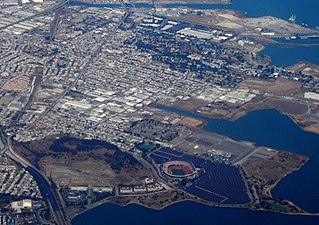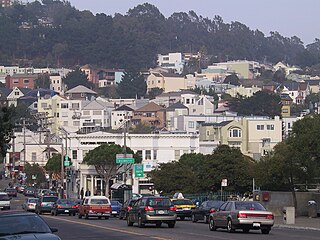
San Francisco, officially the City and County of San Francisco, is a commercial, financial, and cultural center in Northern California. With a population of 808,437 residents as of 2022, San Francisco is the fourth most populous city in the U.S. state of California behind Los Angeles, San Diego, and San Jose. The city covers a land area of 46.9 square miles at the upper end of the San Francisco Peninsula, making it the second-most densely populated major U.S. city behind New York City and the fifth-most densely populated U.S. county, behind four of New York City's boroughs. Among the 92 U.S. cities proper with over 250,000 residents, San Francisco is ranked first by per capita income and sixth by aggregate income as of 2022.

Bayview–Hunters Point is the San Francisco, California, neighborhood combining the Bayview and Hunters Point neighborhoods in the southeastern corner of the city. The decommissioned Hunters Point Naval Shipyard is located within its boundaries and Candlestick Park, which was demolished in 2015, was on the southern edge. Due to the South East location, the two neighborhoods are often merged. Bayview–Hunter's Point has been labeled as San Francisco's "Most Isolated Neighborhood".
The Mission District, commonly known as the Mission, is a neighborhood in San Francisco, California. One of the oldest neighborhoods in San Francisco, the Mission District's name is derived from Mission San Francisco de Asís, built in 1776 by the Spanish. The Mission is historically one of the most notable centers of the city's Chicano/Mexican-American community.

Alamo Square is a residential neighborhood in San Francisco, California with a park of the same name. Located in the Western Addition, its boundaries are Buchanan Street on the east, Turk Street on the north, Baker Street on the west, and Page Street Street on the south.

John McLaren Park is a park in southeastern San Francisco. At 312.54 acres (126.48 ha), McLaren Park is the third largest park in San Francisco by area, after Golden Gate Park and the Presidio. The park is surrounded mostly by the Excelsior, Crocker-Amazon, Visitacion Valley, Portola and University Mound neighborhoods.

Glen Park is a residential neighborhood in San Francisco, California, located south of Twin Peaks and adjacent to Glen Canyon Park.

The Excelsior District is a neighborhood in San Francisco, California.
Potrero Hill is a residential neighborhood in San Francisco, California. A working-class neighborhood until gentrification in the late 1990s, it is now home to mostly upper-income residents.

Dogpatch is a neighborhood in San Francisco, California, roughly half industrial and half residential. It was initially a working class neighborhood, but has experienced rapid gentrification since the 1990s. It now has similar demographics to its western neighbor Potrero Hill – an upper middle-class working professional neighborhood.

Clairemont is a community within the city of San Diego, California, United States. It has a population of about 81,600 residents and an area of roughly 13.3 square miles (34 km2). Clairemont Mesa is bordered by Interstate 805 on the east, Interstate 5 to the west, State Route 52 to the north, and the community of Linda Vista to the south. The community of Clairemont Mesa can be subdivided into the neighborhoods of North Clairemont, Clairemont Mesa East, Clairemont Mesa West, Bay Park, and Bay Ho.

Corona Heights Park is a park in the Castro and Corona Heights neighborhoods of San Francisco, California, United States. It is situated immediately to the south of Buena Vista Park. Corona Heights is bounded in part by Flint Street on the east, Roosevelt Way to the north, and 16th Street to the south. The base of the hill is at approximately 300 feet (91 m), while the peak extends to 520 feet (160 m) above sea level.

Lafayette Park is an 11.49 acres (4.65 ha) park in San Francisco, California, United States. Originally created in 1936, it is located in the neighborhood of Pacific Heights between the streets of Washington, Sacramento, Gough, and Laguna. Located on a hill, the park offers views of many areas, including the city's Marina district, Alcatraz Island and the San Francisco Bay, Buena Vista Park, and Twin Peaks. In addition to both open and treed green spaces, the park includes two tennis courts, a children's playground, an off-leash dog area, restroom facilities, and a picnic area.

The San Francisco Recreation & Parks Department is the city agency responsible for governing and maintaining all city-owned parks and recreational facilities in San Francisco, as well as Sharp Park Golf Course in Pacifica and Camp Mather in Tuolumne County. Current facilities include 4,113 acres (1,664 ha) of total recreational and open space with 3,400 acres (1,376 ha) of that land within San Francisco. The department runs 179 playgrounds and play areas, 82 recreation centers and clubhouses, nine swimming pools, five golf courses, 151 tennis courts, 72 basketball courts, 59 soccer fields, numerous baseball diamonds, and other sports venues.

The Stud is a gay bar currently located on 1123 Folsom Street in San Francisco.

In Chan Kaajal Park is a public park in the Mission District of San Francisco, USA, located north of 17th Street between Folsom and Shotwell Street.

A hill bomb is a maneuver in skateboarding in which a rider rides down a big hill. The trick is noted for its particular danger and, sometimes, grace.

The Liberty Hill Historic District is a historic district located in the Dolores Heights neighborhood of San Francisco, California, U.S.. It is a residential neighborhood bound by 20th, Mission, Dolores, and 22nd Streets. It is listed as a San Francisco Designated Landmark since October 25, 1985.































